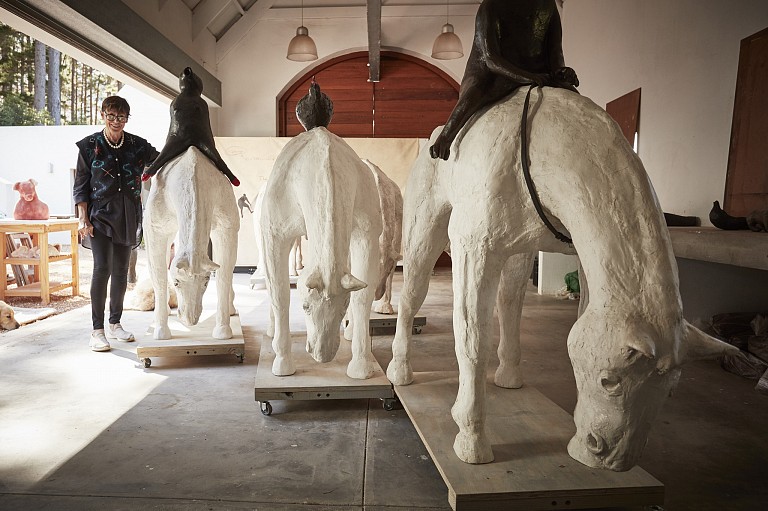
DISCUSSION: Wilma Cruise in preparation for Against Interpretation
May 26, 2020
INSIDE THE ARTIST’S STUDIO
Essay by Wilma Cruise
1984 Fight or Flight: Apocalypse Now? Recycle Re-use Re-con(figure)
Cruise’s sculptures, etchings, drawings, and writing jointly thematise the process of making art — something both physical and mindful; involving materials near at hand, yet also artistic solutions that seem way out of reach. The different materials Cruise beats, cuts, pushes into, and inflicts with stains, marks, bruises and imprints insist themselves as thick matter. …. (Gerhard Schoeman 1987)
The chief imperative of 1984: Fight or Flight: Apocalypse Now? Recycle Re-use and Re-con(figure), (1984 for short) focuses on the relationship between human and other animals. Like the seven consecutive solo shows that constitute the suite of works, The Alice Diaries, (2011 – 2018), the sequence will be realised in a succession of exhibitions. The imperative of the exhibitions was motivated by an anxious awareness of environmental meltdown and crucially the current pandemic. Faced with unbearable environmental conditions, choices for humans, and, critically, other animals, are reduced to a binary conundrum: fight or flight. Following the inchoate need to flee, boat loads of people from the south, take to the perilous waters to cross to the (perceived) safety of the Northern Hemisphere. In central America streams of people coalesce to flow like a great tide of humanity towards the north in search of safer havens. Faced with intolerable decisions, the human flight is echoed by the mass migration of other animals, fleeing drought, wild fires, degradation of their environments and the persecution by the apex predator: Homo Sapiens.
I was mesmerised by the images of overloaded boats crossing perilous seas. Working on the principle of recycling, a number of materials are reemployed in new configurations. Thus, an acrylic fibre horse carries a baboon made of bronze. A wooden boat sails across an imaginary sea carrying a crush of desperate (ceramic) beings.
As in The Alice Diaries where the tales of Alice in Wonderland and Through the Looking Glass acted as a parallel text to the visual objects, the artworks are twinned with literary texts. In this instance, George Orwell’s two dystopian novels, 1984 and Animal Farm. At this cusp in our history, Orwell’s novels are particularly apt in visualising a kind of post-apocalyptic world; even though Orwell’s predictions would take five decades to assert the verity of human hubris. Nevertheless, it is important to note that the artworks do not illustrate nor explain Orwell’s writings. Rather they act as an alternative text – a response as it were to Orwell’s prescient vision.
Alongside the exhibition of the boats is an installation of eight horses. In the spirit of re-purposing and refiguring older works, I used as a template a sculpture of a horse called Poor Horace (2009) to form a cavalcade of identical horses. The horses in the Poor Horace herd subvert the artistic equine tradition in which the nobility and grace of the animal is celebrated. Instead their hooves are firmly planted on a wheeled trolley as if emphasising the dearth of their natural energy. Each horse and its clone carries a rider: a baboon, a human, a human hybrid, a chicken or a cat.
There is a sense of irony in the use of the equine image this way. In the traditional equestrian monument, the power and beauty of the horse is foregrounded usually in the service of man's aggrandisement. The horse and rider are usually placed above the viewers’ heads (to remind the viewers of their insignificance?). The monuments are patriarchal, colonial and phallic. In this genre the horse is both literally and metaphorically an instrument for humankind’s ambitions. In these scenarios little attention seems to be paid to each animal’s uniqueness – its personality or emotional needs.
The three-dimensional works are supported by a range of two dimensional works on canvas or brown paper.
Humankind has appeared to have lost the potential relationship with the animals-as-being. But we can no longer be impartial to their sentience AND crucially, their sapiens. We need to be intimately and emotionally involved and serve as a recognition of our shared being. We need to acknowledge the fellowhood of all creatures on our planet.
Download the full essay here
Back to News



